
“Encroachment Challenges Around Airports: A Growing Security Concern” As investigators probe the cause of the Boeing 787-8 Dreamliner’s fatal descent shortly after take – off on 12 June, which killed 265 people, including 241 passengers and crew, experts are raising concerns about how the encroaching urban landscape may have worsened the disaster.
The aircraft crashed into a medical hostel building within minutes of departure, leading to significant loss of life and damage on the ground.
By Dr. Namrata Mishra Tiwari.
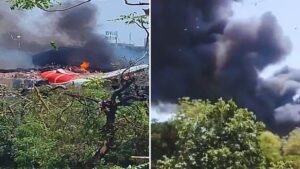
The Encroaching Urban Landscape
Buildings taller than a specified limit within certain zones near the airport disrupt both the physical flight paths and the radio communication between planes and ATC. The final descent of an aircraft is particularly sensitive to any obstruction since the plane is flying at lower altitudes, which increases the risk of interference.
The Ahmedabad air crash#Air India AI171 crash claims lives : tragedy in the skies !! has reawakened calls for integrated urban and aviation planning. Experts argue that ignoring runway length limitations, overlooking height restrictions in the funnel area, and failing to preserve buffer zones around airports all but guarantee future tragedies.
The presence of more open space around the airport might have reduced on-ground casualties. “When an aircraft is forced to make an emergency landing shortly after takeoff, having open, obstruction-free zones can be the difference between a controlled crash and a catastrophe,” an aviation safety analyst said.
Height restrictions around airports are in place by the Civil Aviation Departmenthttp://DGCA to prevent buildings from posing a hazard to air navigation.
Courtsey : https://www.aaiaero
The new Bhartiya Vayuyan Adhiniyam (Aircraft Act) 2024 seeks to address these challenges with enhanced powers for regulators. It mandates stricter penalties for NOC violations, allows for immediate grounding of aircraft where safety is compromised, and aims to plug regulatory loopholes. Needs to be implemented uniformly and in collaboration with local authorities.
Analysis ofhttp://Airports Authority of India (AAI) data reveals wide disparities in permissible construction heights near airports. For instance, at a distance of 4 km from the airport, the maximum approved building height is only 17.87 m in Mumbai — compared to 42.14 m in Vijayawada. Cities like Ahmedabad and Lucknow show minimal increase in height allowance with distance.
As airports give an economic facelift to the region, it transforms the real estate market as well. The impact on the regional real estate market is multi-faceted.
Due to passenger inflow, the demand for retail and hospitality increases multifold, both inside the airport, as well as in close proximity. As direct employment (aviation staff, catering, airport facility management) and indirect employment (ancillary industries such as parking spaces, car rentals, hospitality, etc) boost, the demand for housing increases.
Meanwhile, the airport systematically transforms the region into a robust economic ecosystem which is marked by growth in commercial real estate such as shopping malls, business centers, commercial clusters, IT parks, merchandise marts, etc. In the long run, both commercial and housing real estate feed each other, enabling the path toward phased development.
Choking proximity of high – rises
A longstanding but often overlooked threat to air safety in India the choking proximity of high-rises and dense construction to the airport funnel area. This trend, driven by population growth, infrastructure projects, and increasing demand for real estate, is gradually reducing the safe perimeter around the airport.
These inconsistencies in height thresholds complicate compliance and weaken uniform enforcement. “Without a national standardized approach, the responsibility of safeguarding the air funnel is falling through the cracks,” a former AAI official said
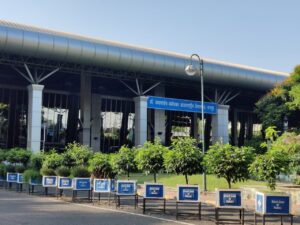
Dr. Baba Saheb International Airport in Nagpur, thehttp://Airports Authority of India (AAI) has identified 63 buildings near the airport that pose a threat to flight paths, with violation including water tanks , extra rooms, and wall built on top of structures. These violations can affect communication between the ground and aircraft.
These buildings include structures that violate height restrictions and other obstructions. The AAI is working with local authorities to address these issues and ensure flight safety.
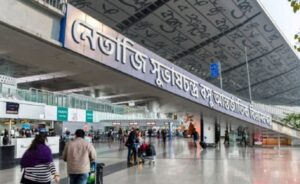
NSCBI Kolkata is the 5th busiest airport in India. And, a recent Obstacle Limitation Surface (OLS) study identified a total of 377 hazards around the Netaji Subhash Chandra Bose International Airport in Kolkata.
While 90 of these have been successfully removed — including several tall trees and parts of illegally constructed buildings — the majority remain in place. These include mobile towers, water tanks, dish antennas, lightning arresters, and unauthorized high-rise structures. Around 287 still pose a threat.

A British-era clock tower near Patna’s Jaiprakash Narayan International airport has once again emerged as safety concern for flight operations with airport authorities warning that its height pose a serious obstacle in the approach path for aircraft. The tower’s proximity prevents the full utilization of the already short runway, an issue persisted for over a decade.
\
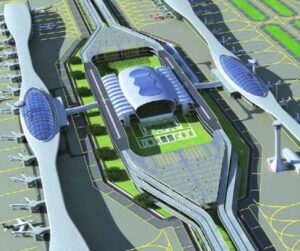
Navi Mumbai International Airport Pvt Limited (NMIAL) http://An Adani Group entity sought details quoting the ministry of Civil Aviation notifications on the height restrictions within 20 km radius of an airport.
The notices of height violations were sent to housing societies in Ulwe, Kharghar and sector 50E of Seawoods in Nerul to safeguard aircraft operations. The violations pertain to hoardings, water tanks, antennas, sheds, parapets, staircases etc.
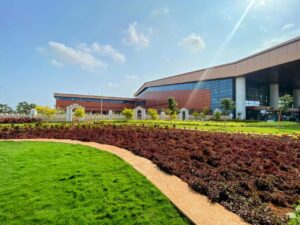
Even Mopa, India’s newest greenfield airport, is not immune. Within months of its inauguration, real estate interest has surged in the surrounding talukas.
With tourism as a major economic driver in Goa, demand for hotels, holiday homes, and commercial projects near the airport is mounting, raising concerns that the safety advantages offered by its initial planning may be gradually eroded if proactive land-use regulation is not enforced.
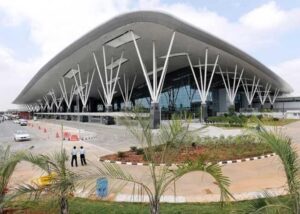
Similar patterns are unfolding in Bengaluru, where the northern corridor surrounding Kempegowda International Airport has transformed into a high-growth zone. What was once largely a rural area is now peppered with tech parks, high-rises, and large-format residential townships. Experts warn that this unregulated vertical growth is beginning to compromise the air funnel area, echoing the issues faced by older airports.
Policy makers and city planners should act decisively
Residential buildings near airports need to adhere to strict height restrictions and other safety regulations to ensure the safety of air travel and the surrounding community.
Aviation experts say that without long-term urban planning and zoning laws that protect air corridors from encroachment, greenfield airports risk repeating the same mistakes of their predecessors. “The initial promise of safety and expansion can be undone in a decade if we allow unregulated growth to creep in,” a senior AAI official said.
As India’s aviation sector grows, so too must its commitment to airspace safety. The question is whether policymakers and city planners will act decisively or continue to allow high-rises to rise unchecked, even in the shadow of the runway.
Greenfield airports, developed on previously unused land, have long been seen as the answer to the congestion and safety challenges plaguing legacy city airports. With ample land banks and carefully planned approach paths, these airports initially offer wide buffer zones, better adherence to obstacle limitation surfaces (OLS), and scope for future expansion.
For other stories : http://indiainput.com
#Air India AI171 crash claims lives : tragedy in the skies !!
#Air India AI171 crash claims lives : tragedy in the skies !!
Social Media’s Double-Edged Sword: Connection and Deception!
Social Media’s Double-Edged Sword: Connection and Deception!
#Chenab Bridge – Symbol of resilience & modern engineering!
Tweets and Teslas : Trump vs Musk “politics meet innovation”
Tweets and Teslas : Trump vs Musk “politics meet innovation”
Gukesh stuns Carlsen!! “Turnaround of the year.”
India has embraced this model, with successful examples like Hyderabad’s Rajiv Gandhi International Airport, Bengaluru’s Kempegowda International Airport, and the newly inaugurated Mopa Airport in north Goa. Each of these was designed to meet modern aviation safety norms and to remain insulated from the risks posed by haphazard urban growth.




